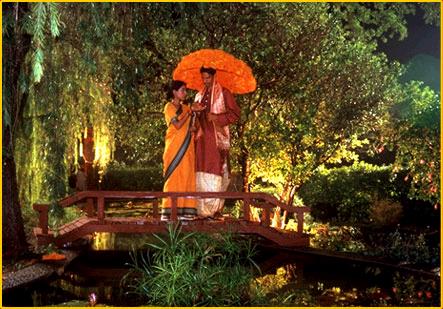
Nargis and Raj Kapoor in one of the most iconic shots of classic Indian cinema from Shree 420 (1955)
After the summer of my sophomore year, I was fortunate enough to intern with my favorite contemporary director Mira Nair. Both of us had studied film production at Harvard University and incidentally under the same professor! I first met Mira at his film screening at the Museum of Modern Art in New York City when I spotted her in the audience. My heart was beating so fast, I could hardly sit still through the screening. After the show, I gave her my impromptu elevator speech and joined the crew at Mirabai Films that summer!
I was twelve years old when I saw Monsoon Wedding (2001) and have yet to find a movie from my generation that I love more. Mira’s other films include Vanity Fair, Salaam Bombay, The Namesake, Kama Sutra, and Amelia, but what does any of this have to do with old Hindi cinema? I want to talk about a side to her movies that you may not have been familiar with—that is, the impact of classic Bollywood on her work.
Perhaps you can recall that scene from Monsoon Wedding in which the wedding planner marries the housemaid beneath an umbrella. Look familiar? It should! Mira was directly inspired by Raj Kapoor’s famous song “Pyaar Hua Iqrar Hua” in directing this scene. Like Nargis and Raj Kapoor walking together on a rainy night, huddled together beneath an umbrella, Mira’s characters strike the same pose to celebrate their romance at the height of the Indian monsoons.
In the front lobby of Mirabai Films hangs an original hand-painted movie poster of Aurat (1940), Mehboob Khan’s little-known precursor to the later smash-hit Mother India (1959). Its relative obscurity (and the eagerness to explain) brings a pride that can only be known to a fellow old Bollywood fanatic. By her desk is a beautiful and fascinating work of photography taken of the interior of R.K. Studios. Mira once explained how the studio in her photograph seems so unassuming and bland, but there, in an inconspicuous back wall besides an empty soda bottle hangs a small, telling picture of the greatest showman of India—Raj Kapoor himself. Despite his wealth and glamour, he and his colleagues maintained an inspiring sense of humility throughout his career that inspired hers.
If you’re looking for more celebrity interest, there is a great scene in her film, Vanity Fair (2004), in which the heroine (played fearlessly by Reese Witherspoon) makes an ill-received attempt to blend in among a high-class dinner party. Guess what? The scene was inspired by none other that the classic song Jaane Woh Kaise from Guru Dutt’s classic Pyaasa! In fact, Mira love it so much and wanted to make sure she captured Dutt’s spirit so precisely, that she got the whole cast together and watched Pyaasa for a movie night before the shoot. You heard me, people. If you have yet to watch Pyaasa yourself and are still looking for reasons to make the commitment, try this: Reese Witherspoon has seen it and you haven’t. Enough said.

Guru Dutt makes the room incredibly uncomfortable in Pyaasa (1957), an inspiration for Reese Witherspoon’s future character in Vanity Fair (2004).
And did you know Mira was very close friends with bold auteur Satyajit Ray? Mira’s favorite of his films include The Apu Trilogy and Days and Night in the Forest (1970), the latter of which was actually screened at the Harvard Film Archive last year with Sharmila Tagore in person! (I obviously had front row seats, almost underwent cardiac arrest upon seeing Sharmila in person, and begged for an autograph that is now framed on my desk. But that’s neither here nor there.) In fact, after growing up on these films, Mira came to respect Sharmila so much as an actress, and eagerly cast her in one of her first indie films called Mississippi Masala (1991)!
There are a million other ways old Bollywood films have influenced her work, and I have highlighted only a few that I know from working with her personally. Watch her films and let us know which others you can spot! Until then, put Pyaasa on your early Christmas list.
-Mrs. 55



